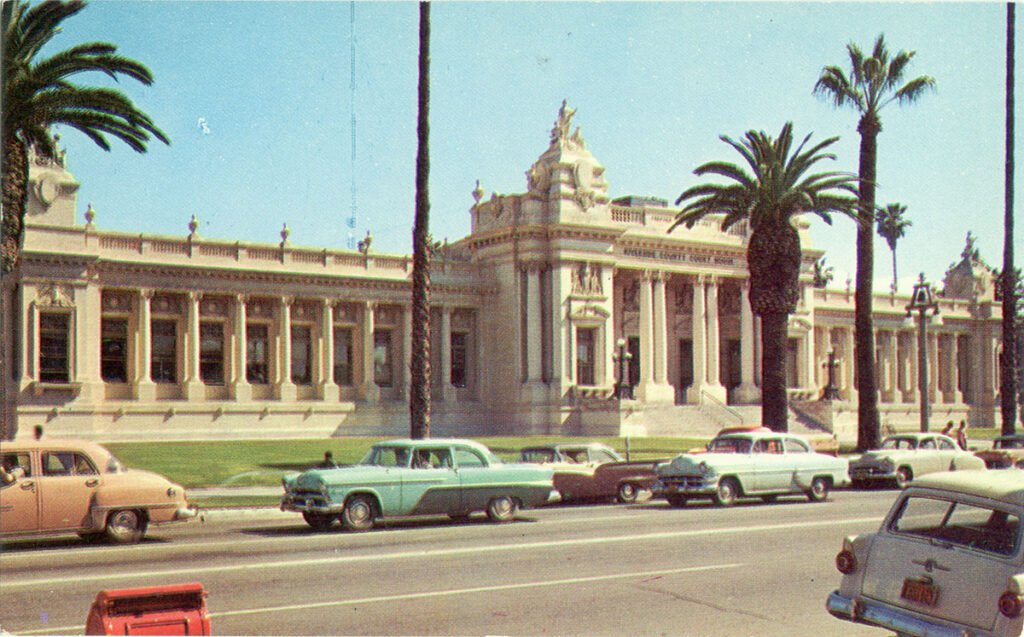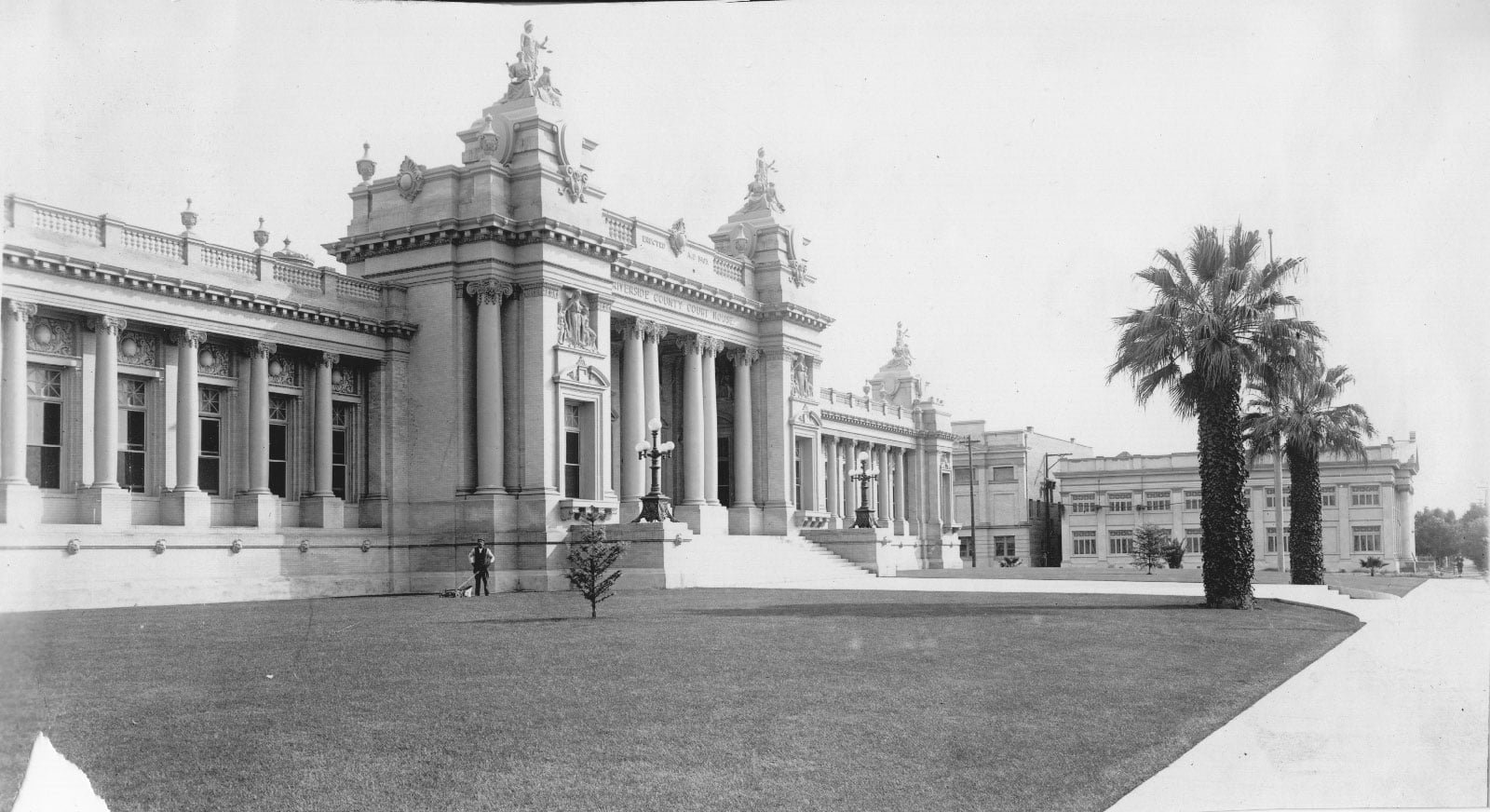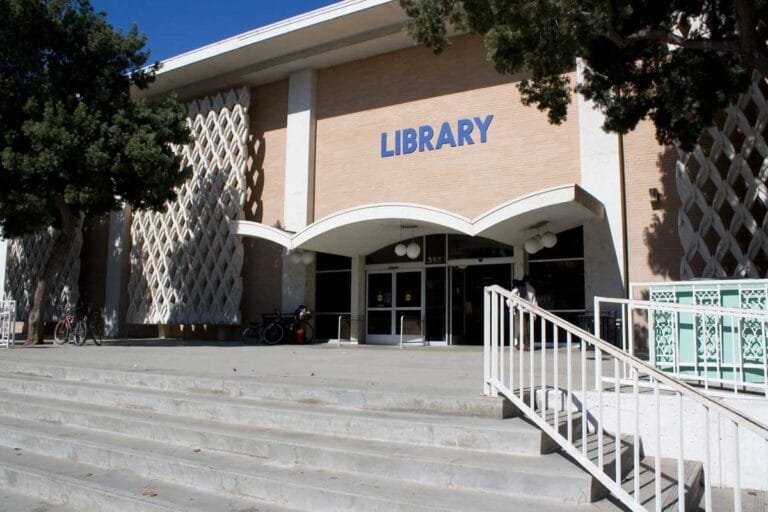Then & Now – Riverside County Courthouse

Considered one of the finest examples of Beaux Arts Classical architecture in the nation, the Riverside County Courthouse is a gem among civic buildings.
Designed by Franklin Pierce Burnham of the architectural firm of Burnham and Bliesner of Los Angeles, the 1903 courthouse is patterned after the Grand Palais (Grand Palace) from the 1900 Universal Exposition (World’s Fair) in Paris (with some inspiration as well from the Petit Palais of the same Paris exposition).
The courthouse, which originally cost approximately $167,875** to construct, was opened for county business in July 1904 and rededicated nearly 100 years later, on October 5, 1998, following a $24.7 million, multi-year renovation and seismic upgrade:
The historic courthouse reopened on schedule after a 4 1/2-year renovation that cost $24.7 million. Almost $1 million in savings, accomplished through tight cost controls, was reinvested to upgrade furnishings, security and other items in the building, said (Henry) Coil, whose company (Tilden-Coil) headed the project.
Riverside Press-Enterprise – October 6, 1998

The picturesque courthouse was, in part, the indirect result of growing dissatisfaction with San Bernardino County — of which at the time included present-day Riverside. Although most historical accounts regarding the formation of Riverside County from a small portion of San Bernardino County and a much larger portion of San Diego County — with Riverside as the county seat — have been streamlined and simplified as being a tax dispute over the building of a new San Bernardino courthouse (at a cost estimated at $350,000), which indeed was a factor. In reality, however, the issue was much more complex, with other factors playing larger roles, each contributing to the overall process. According to local historian Steve Lech in his authoritative and definitive book — Along the Old Roads — covering the decades prior to and including the formation of Riverside County itself, the reason for the formation was not so simple as most accounts have made it out to be:

When we therefore ask the question “Why was Riverside County formed?” the answer cannot be a simple statement such as “San Bernardino wanted a courthouse, so Riverside left.” There were far too many other underlying issues intermixing at the time.
Along the Old Roads – Page 627
In short, the factors that Lech outlines as being the primary issues in county formation were (in no particular order and with paraphrasing context in parenthesis):
- Dissatisfaction with San Bernardino (both as a governing body and as a place of unseemly vices)
- “Hemming In” of Riverside (two other county formation proposals — Pomona/San Antonio and San Jacinto — threatened to forever keep Riverside stuck in San Bernardino County, a situation that was likely “intolerable” to most Riverside residents and community leaders alike)
- The Courthouse Issue (in part due to unjust tax assessments being applied to the higher wealth in Riverside, plus being a tangible argument easy to illustrate, explain, and — for many — to understand)
- The Time was Right (multiple county divisions flooded the state legislature during this time, with Riverside County managing to stay above the rest)
- Distance to County Seat (applied primarily to the much larger portion that was part of San Diego County at the time — and remember, this was way before freeways and other modern traveling modes, such as the automobile itself — explaining why the San Diego portion supported the proposals, first with San Jacinto and later the Riverside proposal)
- County Division Laws (in 1893, after the formation of Riverside County, laws were changed by the state legislature making it more difficult to create new counties)
- Riverside’s Wealth (played a major role, both with regards to influence — including possible improper influence — and economic viability)
- Disunion in Northern San Diego County (following the separate — and failed — attempts to form the counties of San Jacinto and/or Riverside in 1891, outside forces, economic realities, and internal fighting within the San Jacinto camp caused many to instead move support behind a renewed effort to create Riverside County in 1893)

Lech goes into great detail regarding the county’s formation, including — through historical accounts and inference — the important role played by a growing connection between Riverside’s increasing wealth and Southern Pacific Railroad’s huge influence within California’s political circles. In essence, both Riverside and Southern Pacific would mutually benefit with a newly created Riverside County: Riverside would be free from San Bernardino by getting its new county/county seat, and Southern Pacific would avert significantly higher taxes on its vast land holdings most likely to occur under competing county formation proposals (i.e., San Jacinto County). In addition, Southern Pacific would essentially — in return — be granted direct access to Riverside’s very successful and highly lucrative citrus that at the time had been monopolized by Santa Fe. In other words, a win-win for both Riverside and Southern Pacific — not to mention a proverbial death knell to the San Jacinto County proposal.

Of course, following the establishment of Riverside County on May 2, 1893, Riverside now needed to fund and build its own county courthouse. Fortunately, the city’s continuing rise in wealth made such funding much easier. In fact, by 1895 — just 2 years following the establishment of the new county — the city of Riverside was reported by Dun & Bradstreet as the richest city per capita in the United States (thanks primarily to the increasingly successful navel orange). As such, the city soon began the process of commissioning new civic buildings — including the courthouse — that reflected the city’s new wealth and stature.
However, had the city and county gone the expected route of building a Mission Revival-styled courthouse (as backed by influential Mission Inn owner Frank Miller), the elegant courthouse we see today may not have been. Instead, county supervisors were eventually persuaded in favor of a French-inspired, Beaux-Arts design. Without a doubt, the significance of that decision could not be more important today as the unique courthouse stands out among civic buildings.

In the early 1930s, a major expansion to the courthouse by Riverside architect G. Stanley Wilson increased courtrooms on the back (eastern) elevation (Orange Street). Designed to mimic the original Beaux Arts motif, the expansion fits in well against the original design. However, a bulky and spartan 1961 replacement of the county jail on the northwest corner of Eleventh and Orange streets — though unique in its own way — stands out in stark contrast against the magnificently detailed facades of both the original and expansion. (2024 Update: The 1961 jail replacement/addition from Riverside architect Herman O. Ruhnau was demolished in 2012.)
Regardless, thanks to the foresight of county supervisors in 1995, the grand courthouse will stand for generations to come, reminding both residents and visitors alike of the area’s wealth and the vision of local leaders during the city’s — and county’s — formative years.
Flash: County Courthouse: 1960s – 2006
Photo Gallery: Riverside County Courthouse
Related
- Riverside Press-Enterprise – Courthouses in common (Oct. 6, 1998)
- Wikipedia – Grand Palais – Paris | Petit Palais – Paris













**Note: According to the Riverside Daily Press of August 9, 1904, the total cost for the Riverside County Courthouse up to that time was $286,752.88, which included the structure ($167,835.34), jail ($36,837.75), land ($20,000), architect fees ($8,247), and inspector fees ($3,200), with the remainder rounded out by other costs, including curbing and walks, furniture, carpet, and other interior furnishings. The article also noted the final cost was expected to reach $290,000 once landscaping and other expected miscellaneous costs were added.
Sources: “Along the Old Roads – A History of the Portion of Southern California that became Riverside County 1772-1893” (Steve Lech), “Colony for California” (Tom Patterson), Riverside Press-Enterprise (RDP-19040702, RIE-19040705, RDP-19040809, RDP-19611208, PE-19981006), City of Riverside, Museum of Riverside, Wikipedia
2024 PAGE UPDATE: Updated and added substantial context/clarification regarding the formation of Riverside County and the building of/cost for the 1903 courthouse; added newspaper and “Along the Old Roads” citation/insert; added additional photos; updated link to Grand Palais and Petit Palais; removed outdated links to newspaper article, third-party websites, Flash overlay, and photo gallery.


